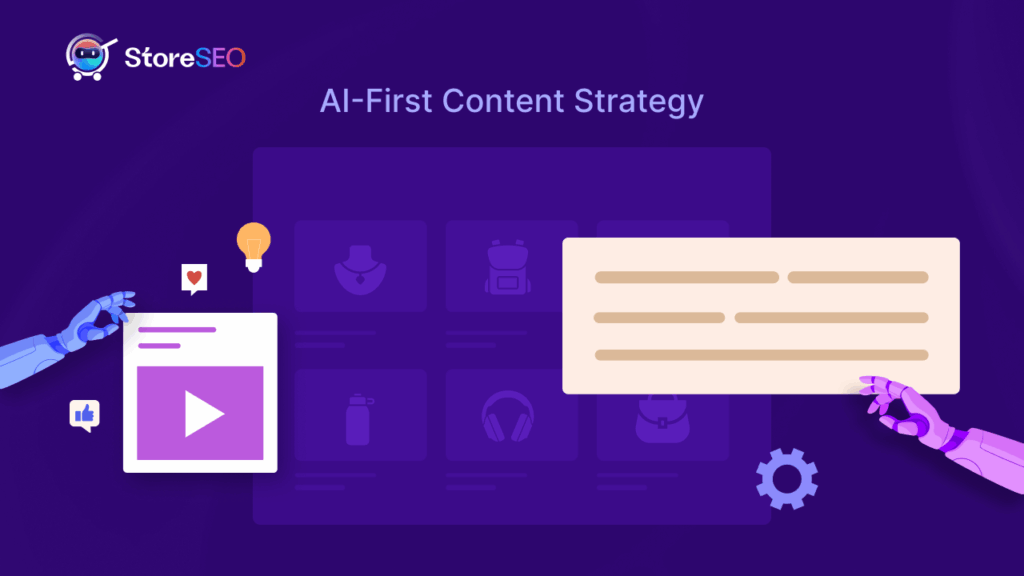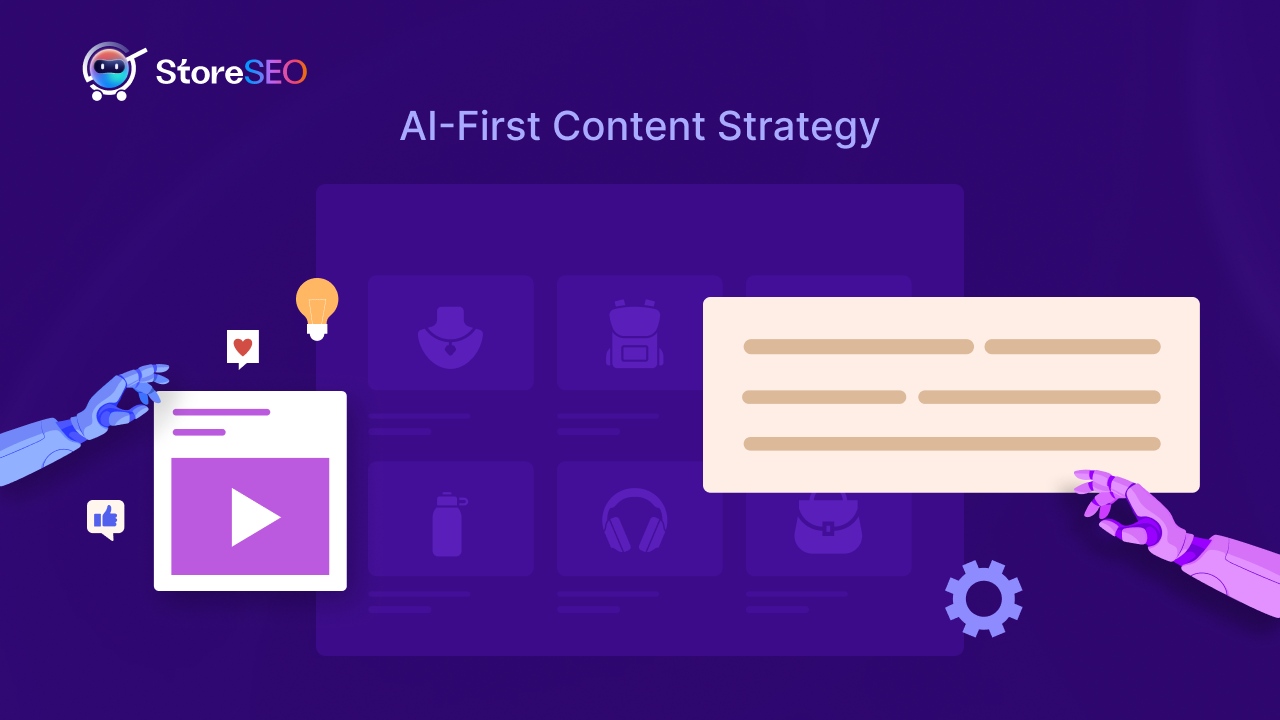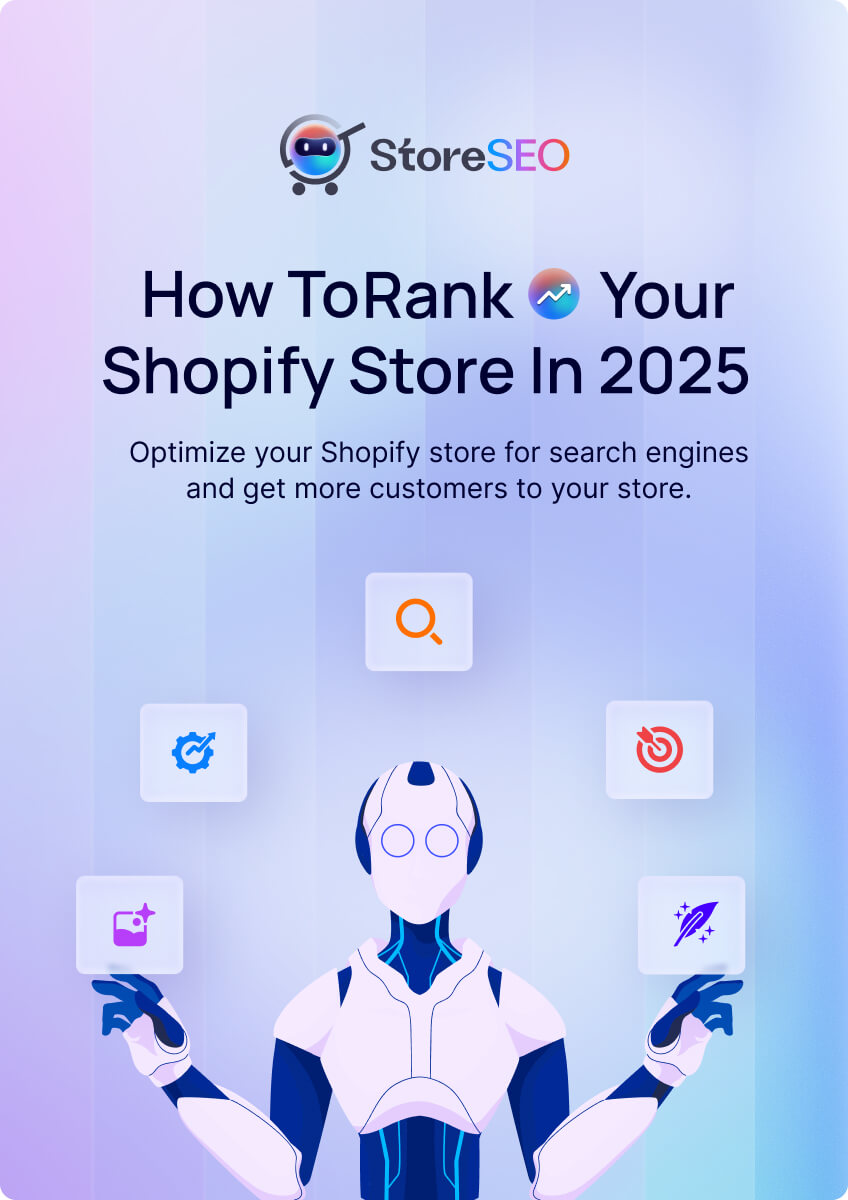An AI-first content strategy can help store owners create personalized, efficient, and impactful content at scale. By using AI tools, you can optimize product descriptions, enhance SEO, and deliver tailored customer experiences that drive sales. This blog explores how to build a simple yet powerful AI-driven content strategy to grow your Shopify store.

Why an AI-First Content Strategy Matters For Shopify Stores
Running a Shopify store means you are competing with thousands of other online shops. To stand out, you need content that grabs attention, connects with customers, and encourages them to buy. AI can help you create this content faster, smarter, and better. An AI-first content strategy means using AI tools to plan, create, and improve your content, so it works harder for your business.
AI can save you time, understand your customers better, and make your store feel more personal. Whether it is writing product descriptions, creating blog posts, or sending emails, AI can help you do it all with less effort. Let us explore how to build this strategy step by step.
Step 1: Understand Your Customers with AI
The first step in any content strategy is knowing who your customers are. AI tools can analyze data from your Shopify store, like what products people buy, what pages they visit, or how long they stay on your site. This information helps you understand what your customers want.
For example, AI can tell you if your customers love eco-friendly products or prefer budget-friendly options. Tools like Google Analytics or Shopify’s built-in reports can give you this data, but AI takes it further. It can spot patterns you might miss, like which products are popular with certain age groups. Use this knowledge to create content that speaks directly to your audience.
Step 2: Create Product Descriptions That Shine
Product descriptions are the heart of your Shopify store. They convince customers to click “Add to Cart.” Writing unique descriptions for every product can take hours, but AI can help. Tools like Copy.ai or Jasper can generate clear, engaging descriptions in seconds.

Here is how it works: You give the AI some details about your product, like its features or benefits. The AI then writes a description that sounds natural and persuasive. For example, if you sell handmade candles, the AI might write: “Light up your home with our soothing lavender candle, crafted with natural wax for a clean, long-lasting burn.” You can tweak the text to match your brand’s voice, but the AI does most of the heavy lifting.
Pro tip: Always review AI-generated content to make sure it feels authentic. Add a touch of your brand’s personality to make it unique.
Step 3: Boost Your Blog with AI
A blog is a great way to bring people to your Shopify store. It can also improve your store’s ranking on search engines like Google. However, coming up with blog ideas and writing posts takes time. AI can help here, too.
AI tools like Frase or SurferSEO can suggest blog topics based on what your customers are searching for. For example, if you sell fitness gear, AI might recommend writing about “Top 5 Home Workouts for Beginners.” These tools can also help you write the post by suggesting an outline or even drafting sections for you.
A blog powered by AI saves you time and helps you create content that people want to read. Plus, it can drive more traffic to your store, which means more sales.
Step 4: Personalize Emails with AI
Email marketing is a powerful way to connect with customers, but sending the same email to everyone is not enough. AI can make your emails feel personal. Tools like Klaviyo or Omnisend use AI to send the right message to the right person at the right time.
For example, if someone abandons their cart, AI can send them a friendly reminder email with a discount code. If a customer buys a winter coat, AI can suggest matching gloves or scarves in the next email. These personalized touches make customers feel special and encourage them to keep shopping.
Step 5: Optimize Your Content for Search Engines
You want your Shopify store to appear at the top of Google searches, right? AI can help with that, too. Search engine optimization (SEO) is about using the right words and phrases so search engines can find your store. AI tools like Clearscope or MarketMuse analyze your content and suggest ways to improve it.
For instance, if you sell organic skincare, AI might suggest adding phrases like “natural face cream” or “chemical-free moisturizer” to your product pages. These small changes can make a big difference in how many people find your store.
Step 6: Use AI to Save Time and Scale Up
One of the best things about an AI-first content strategy is that it saves you time. Instead of spending hours writing or researching, you can let AI handle the repetitive tasks. This gives you more time to focus on other parts of your business, like designing new products or connecting with customers.
As your store grows, AI can scale with you. Need 100 new product descriptions? AI can write them in minutes. Want to send thousands of personalized emails? AI can do that, too. It is like having a super-smart assistant who never gets tired.
Step 7: Keep Learning and Improving
AI is not a set-it-and-forget-it tool. The more you use it, the better it gets. Many AI tools learn from your feedback, so they can create content that matches your style over time. For example, if you tell an AI writing tool to use a fun, casual tone, it will get better at writing that way for you.
Also, keep an eye on your store’s performance. Use Shopify’s analytics to see which AI-generated content is working best. Are your blog posts bringing in more visitors? Are your emails getting more clicks? Use this data to tweak your strategy and make it even stronger.
Bonus Tip: Use AI Chatbots for Customer Support
A great way to enhance your Shopify store is by adding an AI-powered chatbot to handle customer inquiries. Tools like Shopify Inbox or third-party apps can answer common questions, recommend products, and even process orders.
For example, a chatbot can help customers find products by understanding natural language queries, like “I’m looking for a red dress under $50.” This saves you time and improves the shopping experience, as 70% of customers using Shopify Inbox resolve their issues without needing human support. Just make sure to monitor the chatbot to ensure it provides accurate answers and escalates complex issues to a real person when needed.
Create Your Own AI-First Content Strategy Today
Building an AI-first content strategy for your Shopify store is not as hard as it sounds. With the right tools, you can create content that attracts customers, boosts sales, and saves you time. Start small by trying one or two AI tools, and watch how they transform your store. The future of eCommerce is here, and AI is your ticket to staying ahead of the game.
Did you find this blog helpful? If you do, then please share this blog with your community and subscribe to our blog today to get more updates, the latest news, and tutorials.










